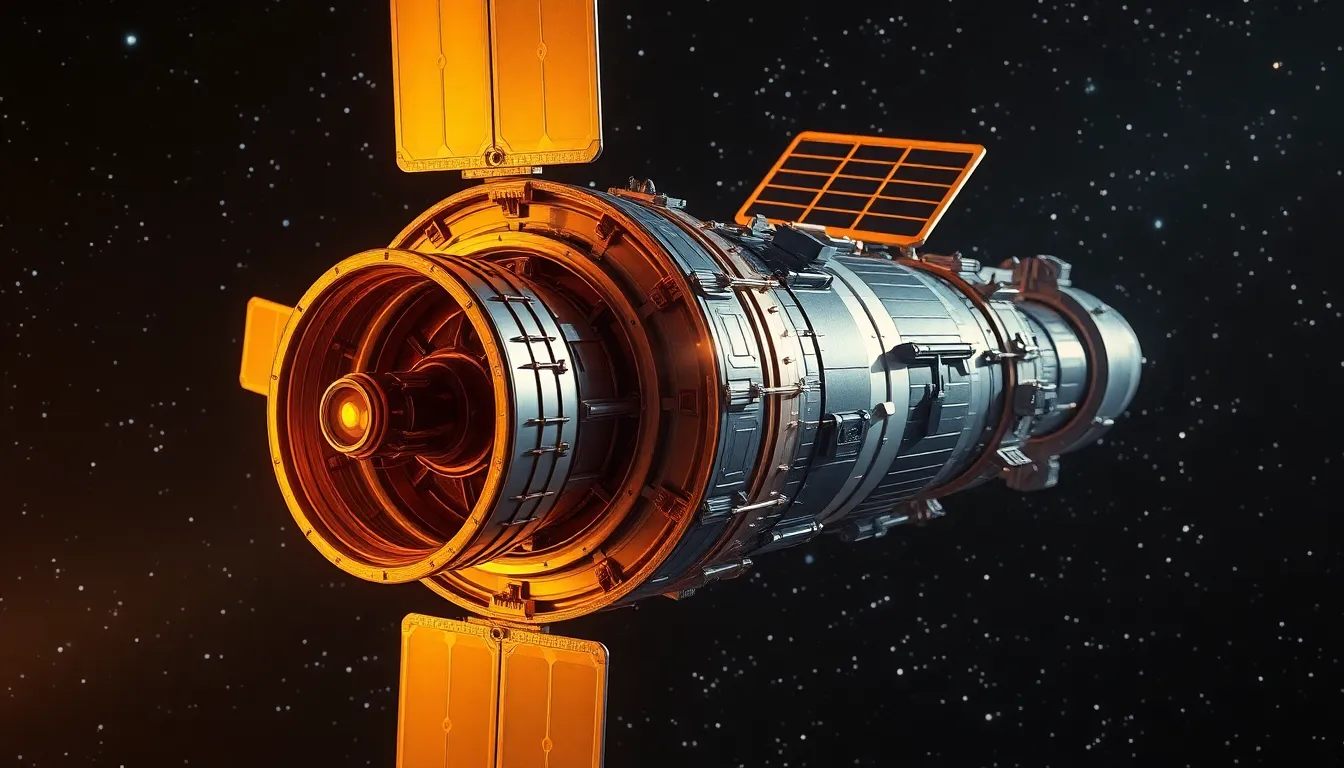In the vast expanse of space, where the only thing thicker than the vacuum is the competition, spacecraft systems play a crucial role in ensuring missions go off without a hitch. Think of them as the unsung heroes of the cosmos, working tirelessly behind the scenes while astronauts take all the glory. From propulsion to power management, these systems are the backbone of any successful space venture, ensuring that rockets don’t just aimlessly drift into the void.
Table of Contents
ToggleOverview of Spacecraft Systems
Spacecraft systems encompass a variety of components essential for the success of space missions. These systems include propulsion, power management, thermal control, and communication. Each part serves a specific function that contributes to overall mission efficacy.
Propulsion systems generate the thrust needed for maneuvering in space. They operate using different methods such as chemical rockets or ion propulsion, enabling precise navigation. Power management systems supply the necessary energy to all spacecraft components, utilizing solar panels or nuclear power sources for reliability.
Thermal control systems maintain optimal temperatures for onboard equipment. Without adequate thermal regulation, instruments risk malfunctioning from extreme heat or cold encountered in space. Communication systems facilitate data transmission between the spacecraft and mission control. These systems utilize antennas and radios to relay important information about the spacecraft’s status and surroundings.
Navigation and guidance systems play a significant role in ensuring accurate and efficient travel. Inertial navigation relies on accelerometers and gyroscopes, while celestial navigation leverages stars for precise positioning. Fault detection systems monitor all spacecraft systems for potential issues, contributing to mission safety.
Robust design and engineering are at the core of spacecraft systems. They must withstand harsh environmental conditions, including radiation and vacuum. Each system integrates seamlessly with others to produce a cohesive operational framework.
Spacecraft systems embody the technological advancements driving space exploration forward. By ensuring functionality across multiple domains, these systems represent the backbone of modern space missions.
Key Components of Spacecraft Systems

Spacecraft systems comprise several vital components that ensure mission success. Each system plays a specific role, contributing to overall functionality and operational efficiency.
Propulsion Systems
Propulsion systems create the thrust necessary for spacecraft maneuverability. These systems typically rely on chemical rockets, which burn propellant for thrust, or electric propulsion systems, which utilize ionized gases for efficient acceleration. NASA’s Space Launch System employs solid rocket boosters alongside liquid engines to maximize power. Effective propulsion systems facilitate orbital insertion, trajectory adjustments, and deorbiting procedures, enabling precise navigation in space.
Power Systems
Power systems distribute energy across the spacecraft. Solar arrays or nuclear generators frequently provide this energy, ensuring longevity and reliability. Solar panels convert sunlight into electricity, powering essential instruments and systems. Batteries store energy for use during eclipses or periods of minimal sunlight exposure. Efficient power management ensures all systems operate optimally, directly impacting mission duration and success rates.
Thermal Control Systems
Thermal control systems maintain stable temperatures within the spacecraft. Components within these systems include insulation materials, radiators, and heaters, each performing essential functions. Insulation protects sensitive equipment from extreme temperatures in space. Radiators dissipate heat generated by onboard systems, while heaters prevent critical components from freezing. These systems work together to ensure that instruments operate within designated temperature ranges, promoting safety and functionality throughout the mission.
Types of Spacecraft Systems
Spacecraft systems can be categorized into two primary types: manned and unmanned. Each category serves distinct purposes and employs various technologies to achieve mission goals.
Manned Spacecraft Systems
Manned spacecraft systems support human activities in space. They incorporate life support systems that provide oxygen, remove carbon dioxide, and regulate temperature. Such systems ensure a habitable environment for astronauts. Communication systems facilitate real-time interaction with mission control, enabling coordination during operations. Power management relies on solar arrays or fuel cells, ensuring energy supply. Thermal control employs insulation and radiative cooling to protect crew members and equipment from temperature extremes. Examples include the International Space Station and Orion spacecraft, emphasizing reliability and safety.
Unmanned Spacecraft Systems
Unmanned spacecraft systems conduct missions without human presence. They often utilize advanced automation for navigation and operation. Remote sensing systems gather data from space, enabling scientific research and Earth observation. Power management in these systems frequently relies on solar panels or radioisotope thermoelectric generators. Communication systems ensure transmission of data back to Earth. Examples include Mars rovers and satellites, demonstrating the capabilities of unmanned operations. These systems focus on achieving objectives even in harsh environments, showcasing their resilience.
Challenges in Spacecraft Systems
Spacecraft systems face significant challenges that can impact mission success. These challenges fall primarily into technological and environmental categories.
Technological Challenges
Technological advancements are essential for spacecraft systems but often present considerable hurdles. Developing reliable components for propulsion or power management requires extensive research and testing. For instance, the integration of new materials or systems, such as electric propulsion, involves addressing potential failure modes. Communication systems must maintain functionality under various conditions, with robust error correction to avoid data loss. Testing for software reliability becomes critical, as many spacecraft rely heavily on automation. Complex interactions between subsystems demand engineers to innovate constantly, ensuring compatibility and performance during missions.
Environmental Challenges
Harsh environments in space create obstacles for spacecraft systems that engineers must navigate. Extreme temperatures threaten the functionality of onboard equipment. During solar flares, radiation levels spike, increasing the risk of system failure. Microgravity also affects how materials behave and requires careful considerations during design. Dust accumulation can hinder solar panel efficiency, impacting power management systems. Moreover, the vacuum of space complicates thermal control, necessitating advanced insulation techniques. Each challenge requires strategic solutions to maintain safety and mission objectives, underscoring the complexity of operating in the vastness of space.
Future Trends in Spacecraft Systems
Emerging technologies are shaping the future of spacecraft systems. Artificial intelligence enhances navigation and decision-making processes, allowing for real-time adjustments during missions. Autonomous systems optimize the routing of spacecraft, minimizing human intervention while boosting efficiency.
Improvements in propulsion methods are expected to revolutionize space travel. Electric propulsion systems are gaining traction, significantly increasing payload capacity and efficiency. Additionally, hybrid propulsion systems combine traditional methods with innovative technologies. These developments promise faster and more efficient missions.
Sustainability in power management is a central focus. Advanced solar panel designs and next-generation nuclear power sources are crucial for increasing energy efficiency and reliability. Enhancing battery storage capabilities facilitates extended missions, ensuring operational continuity during extended periods without sunlight.
Thermal control systems undergo reengineering to adapt to extreme conditions in space. Innovations include advanced materials and techniques for insulation, enabling better temperature regulation for sensitive instruments. Consequently, mission success depends on the ability to manage extreme thermal variations.
Communication systems are also evolving. The integration of satellite networks allows for uninterrupted data transmission, even in challenging conditions. Implementing quantum communication techniques offers promise for faster and more secure communication links with Earth.
Data analytics is playing a key role in monitoring spacecraft systems. Predictive maintenance techniques minimize downtime by identifying potential failures before they occur. This proactive approach improves mission safety and operational effectiveness.
Investment in research and development remains vital for addressing future challenges. Collaboration across international teams fosters innovation and accelerates advancements in spacecraft systems. Exploring new materials and technologies supports the ambition to expand human presence beyond Earth.
Spacecraft systems are integral to the success of space missions. They ensure that both manned and unmanned operations run smoothly while adapting to the challenges of the harsh space environment. As technology evolves, these systems will continue to advance, enhancing navigation, propulsion, and communication.
Investing in research and development will be crucial for overcoming future challenges and expanding humanity’s reach into the cosmos. The ongoing collaboration among nations and organizations will further drive innovation in spacecraft systems. Ultimately, these systems are not just components; they are the backbone of exploration, paving the way for a new era in space travel.




